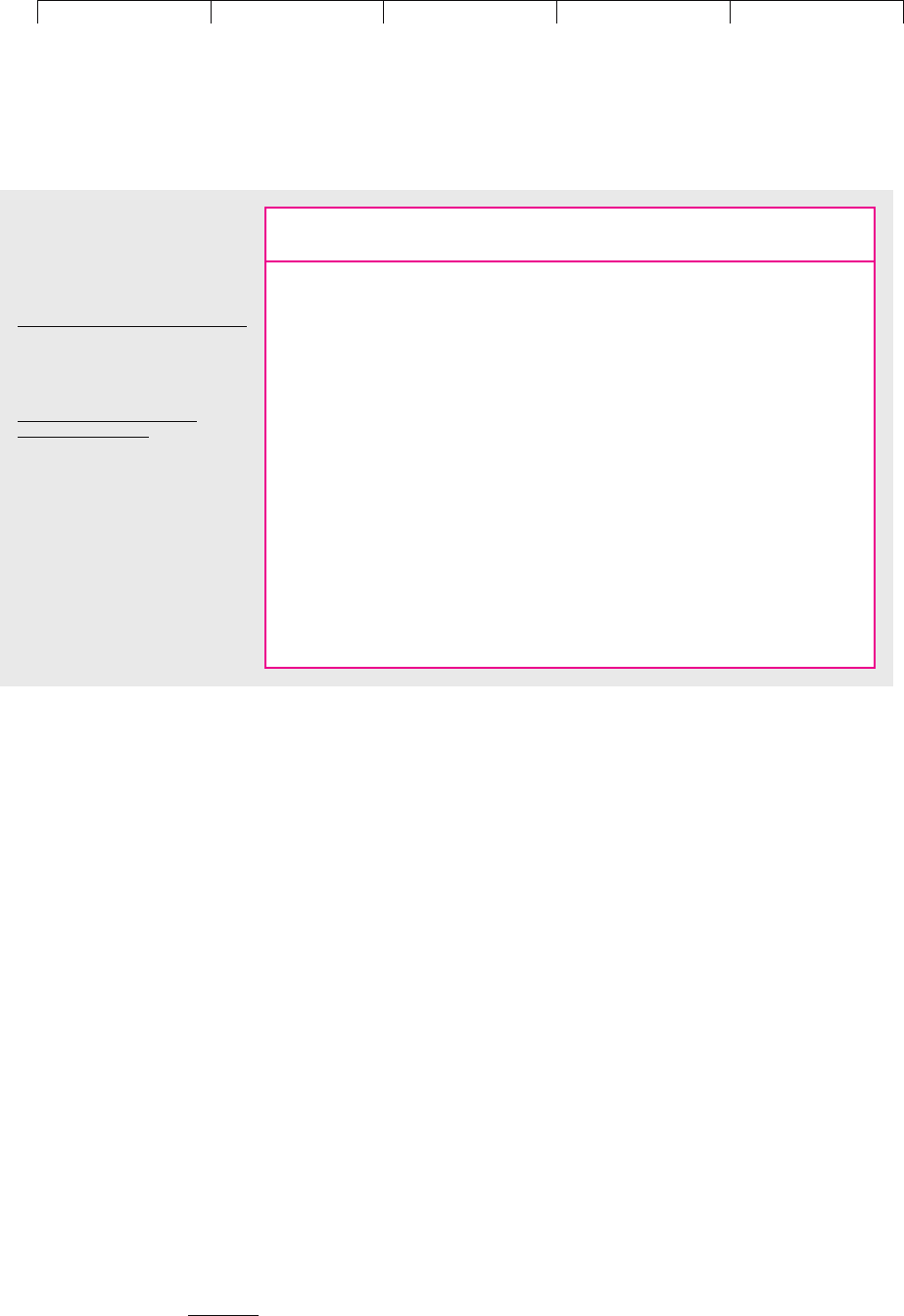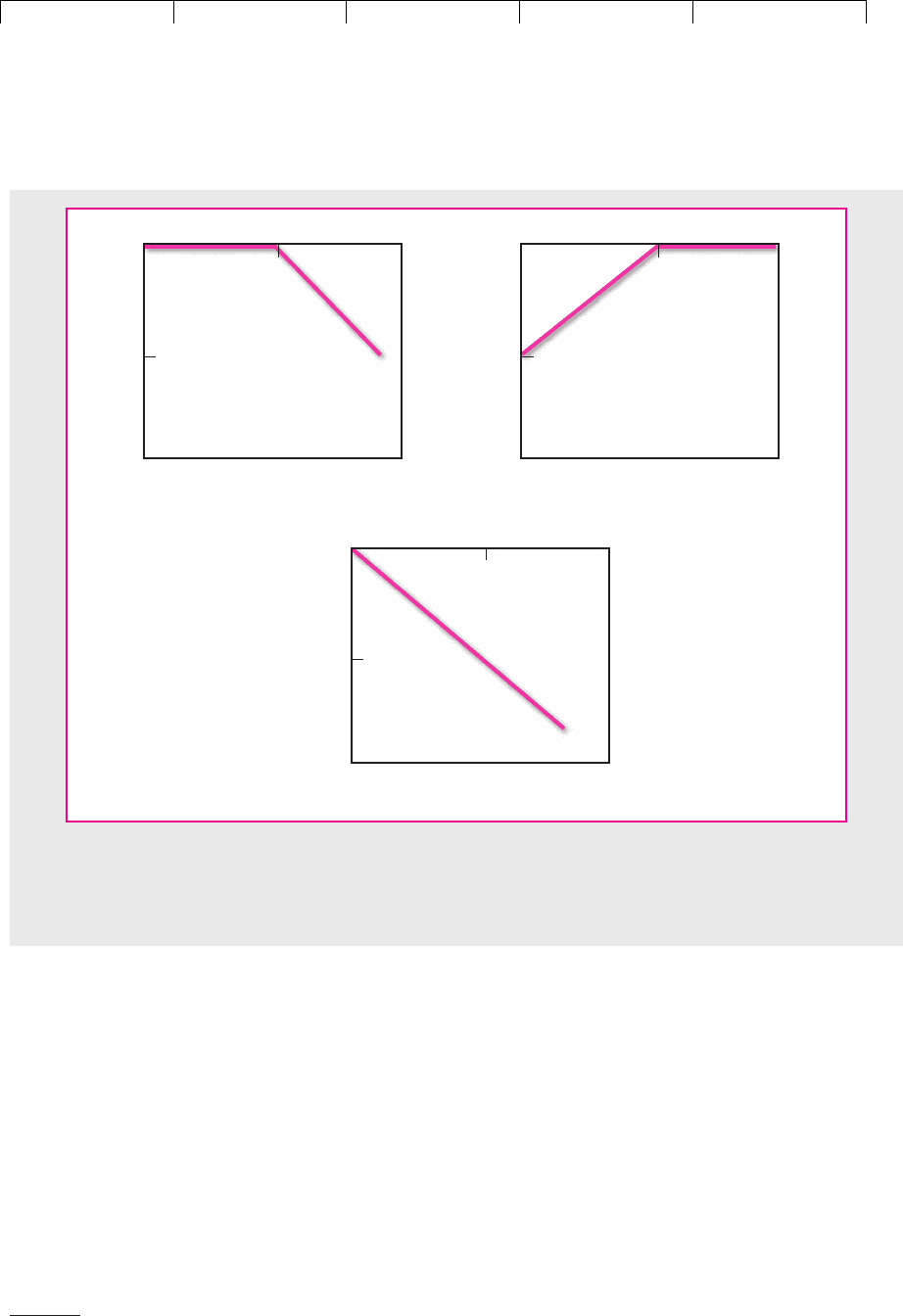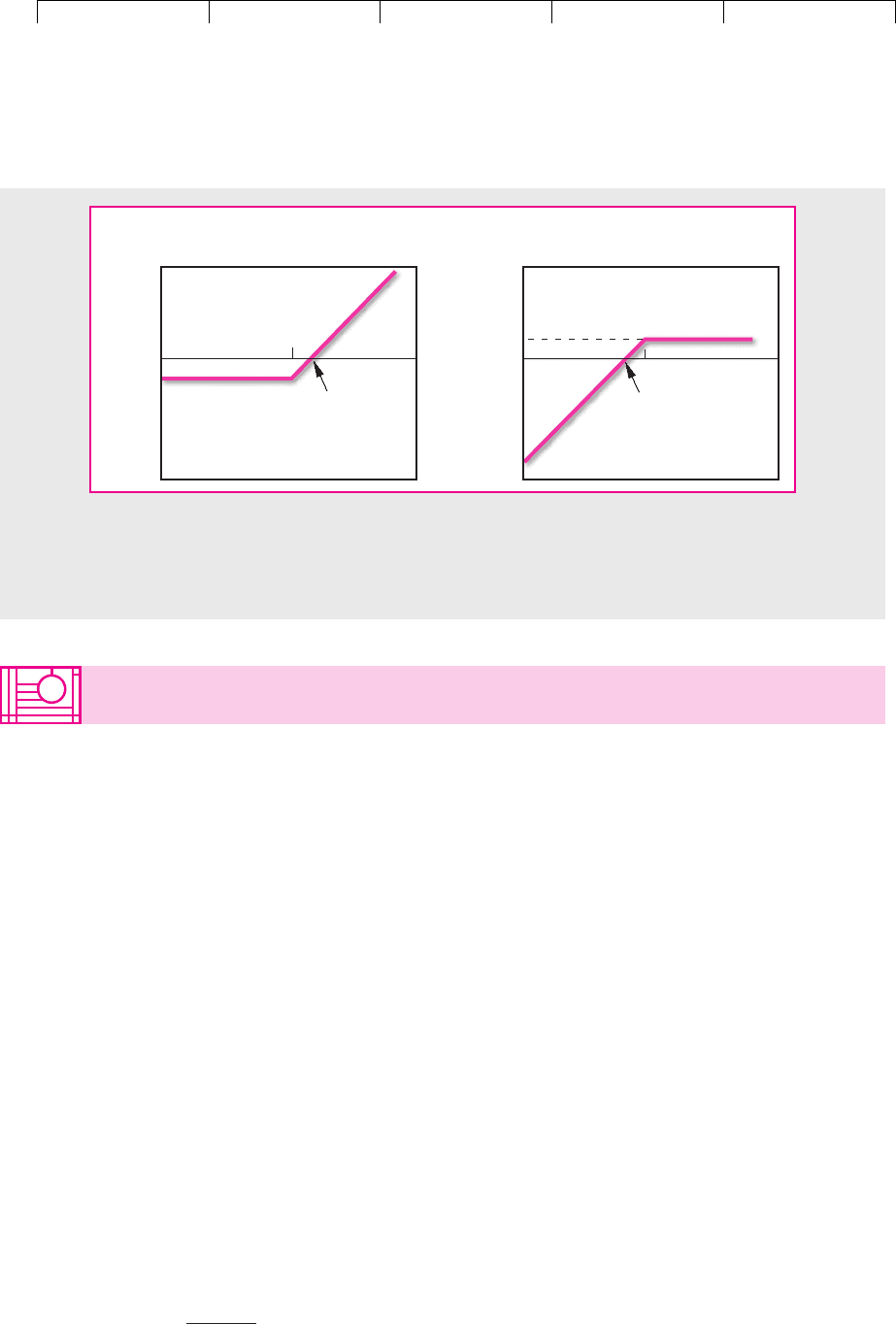Brealey, Myers. Principles of Corporate Finance. 7th edition
Подождите немного. Документ загружается.


Brealey−Meyers:
Principles of Corporate
Finance, Seventh Edition
VI. Options 20. Understanding Options
© The McGraw−Hill
Companies, 2003
FIGURE 20.1(A) SHOWS your payoff if you buy AOL Time Warner (AOL) stock at $55. You gain dollar-
for-dollar if the stock price goes up and you lose dollar-for-dollar if it falls. That’s trite; it doesn’t take
a genius to draw a 45-degree line.
Look now at panel (b), which shows the payoffs from an investment strategy that retains the up-
side potential of AOL stock but gives complete downside protection. In this case your payoff stays
at $55 even if the AOL stock price falls to $50, $40, or zero. Panel (b)’s payoffs are clearly better than
panel (a)’s. If a financial alchemist could turn panel (a) into (b), you’d be willing to pay for the service.
Of course alchemy has its dark side. Panel (c) shows an investment strategy for masochists. You
lose if the stock price falls, but you give up any chance of profiting from a rise in the stock price. If
you like to lose, or if somebody pays you enough to take the strategy on, this is the strategy for you.
Now, as you have probably suspected, all this financial alchemy is for real. You really can do all the
transmutations shown in Figure 20.1. You do them with options, and we will show you how.
But why should the financial manager of an industrial company be interested in options? There are
several reasons. First, companies regularly use commodity, currency, and interest-rate options to re-
duce risk. For example, a meatpacking company that wishes to put a ceiling on the cost of beef might
take out an option to buy live cattle. A company that wishes to limit its future borrowing costs might
take out an option to sell long-term bonds. And so on. In Chapter 27 we will explain how firms em-
ploy options to limit their risk.
Second, many capital investments include an embedded option to expand in the future. For in-
stance, the company may invest in a patent that allows it to exploit a new technology or it may pur-
chase adjoining land that gives it the option in the future to increase capacity. In each case the com-
pany is paying money today for the opportunity to make a further investment. To put it another way,
the company is acquiring growth opportunities.
Here is another disguised option to invest: You are considering the purchase of a tract of desert
land that is known to contain gold deposits. Unfortunately, the cost of extraction is higher than the
current price of gold. Does this mean the land is almost worthless? Not at all. You are not obliged to
mine the gold, but ownership of the land gives you the option to do so. Of course, if you know that
the gold price will remain below the extraction cost, then the option is worthless. But if there is un-
certainty about future gold prices, you could be lucky and make a killing.
1
If the option to expand has value, what about the option to bail out? Projects don’t usually go on
until the equipment disintegrates. The decision to terminate a project is usually taken by manage-
ment, not by nature. Once the project is no longer profitable, the company will cut its losses and ex-
ercise its option to abandon the project. Some projects have higher abandonment value than others.
Those that use standardized equipment may offer a valuable abandonment option. Others may ac-
tually cost money to discontinue. For example, it is very costly to decommission an offshore oil rig.
We took a peek at these investment options in Chapter 10, and we showed there how to use de-
cision trees to analyze Magna Charter’s options to expand its airline operation or abandon it. In Chap-
ter 22 we will take a more thorough look at these real options.
The other important reason why financial managers need to understand options is that they are of-
ten tacked on to an issue of corporate securities and so provide the investor or the company with the
flexibility to change the terms of the issue. For example, in Chapter 23 we will show how warrants and
continued
563
1
In Chapter 11 we valued Kingsley Solomon’s gold mine by calculating the value of the gold in the ground and then subtracting
the value of the extraction costs. That is correct only if we know that the gold will be mined. Otherwise, the value of the mine is in-
creased by the value of the option to leave the gold in the ground if its price is less than the extraction cost.

Brealey−Meyers:
Principles of Corporate
Finance, Seventh Edition
VI. Options 20. Understanding Options
© The McGraw−Hill
Companies, 2003
The Chicago Board Options Exchange (CBOE) was founded in 1973 to allow in-
vestors to buy and sell options on shares of common stock. The CBOE was an al-
most instant success and other exchanges have since copied its example. In addi-
tion to options on individual common stocks, investors can now trade options on
stock indexes, bonds, commodities, and foreign exchange.
Table 20.1 reproduces quotes from the CBOE for June 22, 2001. It shows the
prices for two types of options on AOL stock—calls and puts. We will explain each
in turn.
Call Options and Position Diagrams
A call option gives its owner the right to buy stock at a specified exercise or strike
price on or before a specified exercise date. If the option can be exercised only on
one particular day, it is conventionally known as a European call; in other cases
564 PART VI
Options
convertibles give their holders an option to buy common stock in exchange for cash or bonds. Then in
Chapter 25 we will see how corporate bonds may give the issuer or the investor the option of early
repayment.
In fact, we shall see that whenever a company borrows, it creates an option. The reason is that the
borrower is not compelled to repay the debt at maturity. If the value of the company’s assets is less
than the amount of the debt, the company will choose to default on the payment and the bond-
holders will get to keep the company’s assets. Thus, when the firm borrows, the lender effectively ac-
quires the company and the shareholders obtain the option to buy it back by paying off the debt.
This is an extremely important insight. It means that anything that we can learn about traded options
applies equally to corporate liabilities.
2
In this chapter we use traded stock options to explain how options work, but we hope that our
brief survey has convinced you that the interest of financial managers in options goes far beyond
traded stock options. That is why we are asking you to invest here to acquire several important ideas
for use later.
If you are unfamiliar with the wonderful world of options, it may seem baffling on first encounter.
We will therefore divide this chapter into three bite-sized pieces. Our first task is to introduce you to
call and put options and to show you how the payoff on these options depends on the price of the
underlying asset. We will then show how financial alchemists can combine options to produce the in-
teresting strategies depicted in Figure 20.1 (b) and (c).
We conclude the chapter by identifying the variables that determine option values. Here you will
encounter some surprising and counterintuitive effects. For example, investors are used to thinking
that increased risk reduces present value. But for options it is the other way around.
2
This relationship was first recognized by Fischer Black and Myron Scholes, in “The Pricing of Options
and Corporate Liabilities,” Journal of Political Economy 81 (May–June 1973), pp. 637–654.
20.1 CALLS, PUTS, AND SHARES

Brealey−Meyers:
Principles of Corporate
Finance, Seventh Edition
VI. Options 20. Understanding Options
© The McGraw−Hill
Companies, 2003
(such as the AOL options shown in Table 20.1), the option can be exercised on or at
any time before that day, and it is then known as an American call.
The third column of Table 20.1 sets out the prices of AOL Time Warner call op-
tions with different exercise prices and exercise dates. Look at the quotes for op-
tions maturing in October 2001. The first entry says that for $10.50 you could re-
quire an option to buy one share
3
of AOL stock for $45 on or before October 2001.
Moving down to the next row, you can see that an option to buy for $5 more
($50 vs. $45) costs $3.75 less, that is $6.75. In general, the value of a call option goes
down as the exercise price goes up.
Now look at the quotes for options maturing in January 2002 and 2003. Notice
how the option price increases as option maturity is extended. For example, at an
CHAPTER 20
Understanding Options 565
Lose
if stock
price falls
Lose
if stock
price falls
Win if stock
price rises
Your
payoff
Future
stock
price
$55
(
a
)
Win if stock
price rises
Your
payoff
Future
stock
price
$55
(
b
)
Protected on
downside
No upside
Your
payoff
Future
stock
price
$55
(
c
)
FIGURE 20.1
Payoffs to three investment strategies for AOL stock. (a) You buy one share for $55. (b) No downside. If
stock price falls, your payoff stays at $55. (c) A strategy for masochists? You lose if stock price falls, but
you don’t gain if it rises.
3
You can’t actually buy an option on a single share. Trades are in multiples of 100. The minimum order
would be for 100 options on 100 AOL shares.

Brealey−Meyers:
Principles of Corporate
Finance, Seventh Edition
VI. Options 20. Understanding Options
© The McGraw−Hill
Companies, 2003
exercise price of $60, the October 2001 call option costs $2.10, the January 2002 op-
tion costs $3.75, and the January 2003 option costs $8.80.
In Chapter 13 we met Louis Bachelier, who in 1900 first suggested that security
prices follow a random walk. Bachelier also devised a very convenient shorthand
to illustrate the effects of investing in different options.
4
We will use this shorthand
to compare three possible investments in AOL—a call option, a put option, and the
stock itself.
The position diagram in Figure 20.2(a) shows the possible consequences of investing
in AOL January 2002 call options with an exercise price of $55 (boldfaced in Table
20.1). The outcome from investing in AOL calls depends on what happens to the stock
price. If the stock price at the end of this six-month period turns out to be less than the
$55 exercise price, nobody will pay $55 to obtain the share via the call option. Your call
will in that case be valueless, and you will throw it away. On the other hand, if the
stock price turns out to be greater than $55, it will pay to exercise your option to buy
the share. In this case the call will be worth the market price of the share minus the
$55 that you must pay to acquire it. For example, suppose that the price of AOL stock
rises to $100. Your call will then be worth . That is your payoff, but
of course it is not all profit. Table 20.1 shows that you had to pay $5.75 to buy the call.
Put Options
Now let us look at the AOL put options in the right-hand column of Table 20.1.
Whereas the call option gives you the right to buy a share for a specified exercise
price, the comparable put gives you the right to sell the share. For example, the
$100 $55 $45
566 PART VI
Options
Exercise Price of Price of Put
Option Maturity Price Call Option Option
October 2001 $ 45 $10.50 $ 1.97
50 6.75 3.15
55 3.85 5.25
60 2.10 8.50
65 1.07 12.50
70 .52 17.10
January 2002 $ 45 $12.00 $ 2.90
50 8.45 4.35
55 5.75 6.55
60 3.75 9.55
65 2.25 13.20
70 1.45 17.50
January 2003* $ 50 $13.30 $ 7.30
60 8.80 12.40
70 5.90 19.40
80 3.85 27.80
100 1.70 47.00
TABLE 20.1
Prices of call and put options on
AOL Time Warner stock on
June 22, 2001. The closing
stock price was $53.10.
*Long-term options are called
“LEAPS.”
Source: Chicago Board Options
Exchange. Average of bid and asked
quotes as reported at
www.cboe.com/MktQuote/
DelayedQuotes.asp.
4
L. Bachelier, Théorie de la Speculation, Gauthier-Villars, Paris, 1900. Reprinted in English in P. H.
Cootner (ed.), The Random Character of Stock Market Prices, M.I.T. Press, Cambridge, MA, 1964.

Brealey−Meyers:
Principles of Corporate
Finance, Seventh Edition
VI. Options 20. Understanding Options
© The McGraw−Hill
Companies, 2003
boldfaced entry in the right-hand column of Table 20.1 shows that for $6.55 you
could acquire an option to sell AOL stock for a price of $55 anytime before January
2002. The circumstances in which the put turns out to be profitable are just the op-
posite of those in which the call is profitable. You can see this from the position di-
agram in Figure 20.2(b). If AOL’s share price immediately before expiration turns
out to be greater than $55, you won’t want to sell stock at that price. You would do
better to sell the share in the market, and your put option will be worthless. Con-
versely, if the share price turns out to be less than $55, it will pay to buy stock at the
low price and then take advantage of the option to sell it for $55. In this case, the
value of the put option on the exercise date is the difference between the $55 pro-
ceeds of the sale and the market price of the share. For example, if the share is
worth $35, the put is worth $20:
$55 $35 $20
Value of put option at expiration exercise price market price of the share
CHAPTER 20
Understanding Options 567
$55
(
a
)
$55
(
b
)
$55
(
c
)
$55
$55
$55
Value of
call
Value of
put
Value
of share
Share
price
Share
price
Share
price
FIGURE 20.2
Position diagrams show how payoffs to owners of AOL calls, puts, and shares (shown by the colored lines)
depend on the share price. (a) Result of buying AOL call exercisable at $55. (b) Result of buying AOL put
exercisable at $55. (c) Result of buying AOL share.

Brealey−Meyers:
Principles of Corporate
Finance, Seventh Edition
VI. Options 20. Understanding Options
© The McGraw−Hill
Companies, 2003
Table 20.1 confirms that the value of a put increases when the exercise price is raised.
However, extending the maturity date makes both puts and calls more valuable.
We have now reviewed position diagrams for investment in calls and puts. A
third possible investment is directly in AOL stock. Figure 20.2(c) betrays few se-
crets when it shows that the value of this investment is always exactly equal to the
market value of the share.
Selling Calls, Puts, and Shares
Let us now look at the position of an investor who sells these investments. If you
sell, or “write,” a call, you promise to deliver shares if asked to do so by the call
buyer. In other words, the buyer’s asset is the seller’s liability. If by the exercise
date the share price is below the exercise price, the buyer will not exercise the call
and the seller’s liability will be zero. If it rises above the exercise price, the buyer
will exercise and the seller will give up the shares. The seller loses the difference
between the share price and the exercise price received from the buyer. Notice that
it is the buyer who always has the option to exercise; the seller simply does as he
or she is told.
Suppose that the price of AOL stock turns out to be $80, which is above the option’s
exercise price of $55. In this case the buyer will exercise the call. The seller is forced to
sell stock worth $80 for only $55 and so has a payoff of .
5
Of course, that $25 loss
is the buyer’s gain. Figure 20.3(a) shows how the payoffs to the seller of the AOL call
option vary with the stock price. Notice that for every dollar the buyer makes, the
seller loses a dollar. Figure 20.3(a) is just Figure 20.2(a) drawn upside down.
In just the same way we can depict the position of an investor who sells, or
writes, a put by standing Figure 20.2(b) on its head. The seller of the put has agreed
to pay the exercise price of $55 for the share if the buyer of the put should request
it. Clearly the seller will be safe as long as the share price remains above $55 but
will lose money if the share price falls below this figure. The worst thing that can
happen is that the stock becomes worthless. The seller would then be obliged to
pay $55 for a stock worth $0. The “value” of the option position would be .
Finally, Figure 20.3(c) shows the position of someone who sells AOL stock short.
Short sellers sell stock which they do not yet own. As they say on Wall Street:
He who sells what isn’t his’n
Buys it back or goes to prison.
Eventually, therefore, the short seller will have to buy the stock back. The short
seller will make a profit if it has fallen in price and a loss if it has risen.
6
You can see
that Figure 20.3(c) is simply an upside-down Figure 20.2(c).
Position Diagrams Are Not Profit Diagrams
Position diagrams show only the payoffs at option exercise; they do not account for
the initial cost of buying the option or the initial proceeds from selling it.
This is a common point of confusion. For example, the position diagram in Fig-
ure 20.2(a) makes purchase of a call look like a sure thing—the payoff is at worst
$55
$25
568 PART VI
Options
5
The seller has some consolation, for he or she was paid $5.75 in June for selling the call.
6
Selling short is not as simple as we have described it. For example, a short seller usually has to put up
margin, that is, deposit cash or securities with the broker. This assures the broker that the short seller
will be able to repurchase the stock when the time comes to do so.

Brealey−Meyers:
Principles of Corporate
Finance, Seventh Edition
VI. Options 20. Understanding Options
© The McGraw−Hill
Companies, 2003
zero, with plenty of “upside” if AOL’s stock price goes above $55 by January 2002.
But compare the profit diagram in Figure 20.4(a), which subtracts the $5.75 cost of the
call in June 2001 from the payoff at maturity. The call buyer loses money at all share
prices less than . Take another example: The position diagram
in Figure 20.3(b) makes selling a put look like a sure loss—the best payoff is zero. But
the profit diagram in Figure 20.4(b), which recognizes the $6.55 received by the
seller, shows that the seller gains at all prices above .
7
Profit diagrams like those in Figure 20.4 may be helpful to the options beginner,
but options experts rarely draw them. Now that you’ve graduated from the first
options class we won’t draw them either. We will stick to position diagrams, be-
cause you have to zero in on payoffs at exercise to understand options and to value
them properly.
$55 6.55 $48.45
$55 5.75 $60.75
CHAPTER 20
Understanding Options 569
$55
(
a
)
$55
(
b
)
$55
(
c
)
$55
$55
$55
0
0
0
Share
price
Share
price
Share
price
Value of call
seller's position
Value of put
seller's position
Value of stock
seller's position
FIGURE 20.3
Payoffs to sellers of AOL calls, puts, and shares (shown by the colored lines) depend on the share price.
(a) Result of selling AOL call exercisable at $55. (b) Result of selling AOL put exercisable at $55. (c) Result of
selling AOL share short.
7
Strictly speaking, the profit diagrams in Figure 20.4 should account for the time value of money, that
is, the interest earned on the seller’s initial proceeds and lost on the call buyer’s outlay.

Brealey−Meyers:
Principles of Corporate
Finance, Seventh Edition
VI. Options 20. Understanding Options
© The McGraw−Hill
Companies, 2003
Now that you understand the possible payoffs from calls and puts, we can start
practicing some financial alchemy by conjuring up the strategies shown in Figure
20.1. Let’s start with the strategy for masochists.
Look at row 1 of Figure 20.5. The first diagram shows the payoffs from buying
a share of AOL stock, while the second shows the payoffs from selling a call option
with a $55 exercise price. The third diagram shows what happens if you combine
these two positions. The result is the no-win strategy that we depicted in panel
(c) of Figure 20.1. You lose if the stock price declines below $55, but, if the stock
price rises above $55, the owner of the call option will demand that you hand over
your stock for the $55 exercise price. So you lose on the downside and give up any
chance of a profit. That’s the bad news. The good news is that you get paid for tak-
ing on this liability. In June 2001 you would have been paid $5.75, the price of a six-
month call option.
Now, we’ll create the downside protection shown in Figure 20.1(b). Look at row
2 of Figure 20.5. The first diagram again shows the payoff from buying a share of
AOL stock, while the next diagram in row 2 shows the payoffs from buying an
AOL put option with an exercise price of $55. The third diagram shows the effect
of combining these two positions. You can see that, if AOL’s stock price rises above
$55, your put option is valueless, so you simply receive the gains from your in-
vestment in the share. However, if the stock price falls below $55, you can exercise
your put option and sell your stock for $55. Thus, by adding a put option to your
investment in the stock, you have protected yourself against loss.
8
This is the strat-
egy that we depicted in panel (b) of Figure 20.1. Of course, there is no gain without
pain. The cost of insuring yourself against loss is the amount that you pay for a put
570 PART VI
Options
$55
(
a
) Profit to call buyer (
b
) Profit to put seller
–$5.75
0
$6.55
Share
price
Share
price
Breakeven
is $60.75
$55
0
Breakeven
is $48.45
FIGURE 20.4
Profit diagrams incorporate the costs of buying an option or the proceeds from selling one. In panel
(a), we substract the $5.75 cost of the AOL call from the payoffs plotted in Figure 20.2(a). In panel
(b), we add the $6.55 proceeds from selling the AOL put to the payoffs in Figure 20.3(b).
20.2 FINANCIAL ALCHEMY WITH OPTIONS
8
This combination of a stock and a put option is known as a protective put.

Brealey−Meyers:
Principles of Corporate
Finance, Seventh Edition
VI. Options 20. Understanding Options
© The McGraw−Hill
Companies, 2003
option on AOL stock with an exercise price of $55. In June 2001 the price of this put
was $6.55. This was the going rate for financial alchemists.
We have just seen how put options can be used to provide downside protection.
We will now show you how call options can be used to get the same result. This is
illustrated in row 3 of Figure 20.5. The first diagram shows the payoff from placing
the present value of $55 in a bank deposit. Regardless of what happens to the price
of AOL stock, your bank deposit will pay off $55. The second diagram in row 3
shows the payoff from a call option on AOL stock with an exercise price of $55, and
CHAPTER 20
Understanding Options 571
$55
Buy share
Your
payoff
Future
stock
price
$55
Sell call
Your
payoff
Future
stock
price
$55
No upside
Your
payoff
Future
stock
price
+=
$55
Buy share
Your
payoff
Future
stock
price
$55
Buy put
Your
payoff
Future
stock
price
$55
Downside
protection
Downside
protection
Your
payoff
Future
stock
price
+=
$55
$55
Bank deposit paying $55
Your
payoff
Future
stock
price
$55
Buy call
Your
payoff
Future
stock
price
$55
Your
payoff
Future
stock
price
+=
FIGURE 20.5
The first row shows how options can be used to create a strategy where you lose if the stock price falls but do not gain
if it rises [strategy (c) in Figure 20.1]. The second and third rows show two ways to create the reverse strategy where
you gain on the upside but are protected on the downside [strategy (b) in Figure 20.1].

Brealey−Meyers:
Principles of Corporate
Finance, Seventh Edition
VI. Options 20. Understanding Options
© The McGraw−Hill
Companies, 2003
the third diagram shows the effect of combining these two positions. Notice that,
if the price of AOL stock falls, your call is worthless, but you still have your $55 in
the bank. For every dollar that AOL stock price rises above $55, your investment in
the call option pays off an extra dollar. For example, if the stock price rises to $100,
you will have $55 in the bank and a call worth $45. Thus you participate fully
in any rise in the price of the stock, while being fully protected against any fall. So
we have just found another way to provide the downside protection depicted in
panel (b) of Figure 20.1.
These last two rows of Figure 20.5 tell us something about the relationship be-
tween a call option and a put option. Regardless of the future stock price, both in-
vestment strategies provide identical payoffs. In other words, if you buy the share
and a put option to sell it after six months for $55, you receive the same payoff as
from buying a call option and setting enough money aside to pay the $55 exercise
price. Therefore, if you are committed to holding the two packages until the op-
tions expire, the two packages should sell for the same price today. This gives us a
fundamental relationship for European options:
To repeat, this relationship holds because the payoff of
is identical to the payoff from
This basic relationship among share price, call and put values, and the present
value of the exercise price is called put–call parity.
10
The relationship can be expressed in several ways. Each expression implies two
investment strategies that give identical results. For example, suppose that you
want to solve for the value of a put. You simply need to twist the put–call parity
formula around to give
From this expression you can deduce that
is identical to
In other words, if puts are not available, you can create them by buying calls, put-
ting cash in the bank, and selling shares.
3Buy call,
invest present value of exercise price in safe asset, sell share4
3buy put4
Value of put value of call present value of exercise price share price
3Buy put,
buy share4
3Buy call, invest present value of exercise price in safe asset
9
4
Value of call present value of exercise price value of put share price
572 PART VI
Options
9
The present value is calculated at the risk-free rate of interest. It is the amount that you would have
to invest today in a bank deposit or Treasury bills to realize the exercise price on the option’s expira-
tion date.
10
Put–call parity holds only if you are committed to holding the options until the final exercise date. It
therefore does not hold for American options, which you can exercise before the final date. We discuss
possible reasons for early exercise in Chapter 21. Also if the stock makes a dividend payment before the
final exercise date, you need to recognize that the investor who buys the call misses out on this divi-
dend. In this case the relationship is
Value of call present value of exercise price value of put share price present value of dividend.
